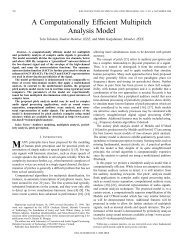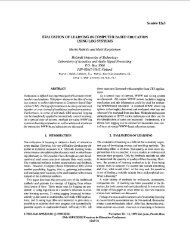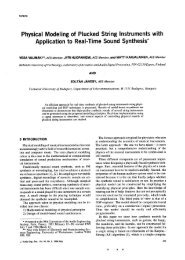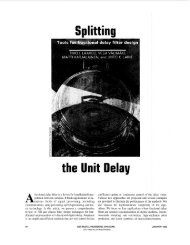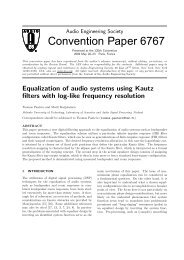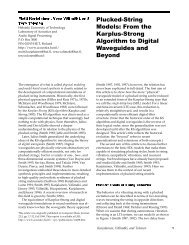On the numerical solution of the 2D wave equation
On the numerical solution of the 2D wave equation
On the numerical solution of the 2D wave equation
Create successful ePaper yourself
Turn your PDF publications into a flip-book with our unique Google optimized e-Paper software.
Proc. <strong>of</strong> <strong>the</strong> 11 th Int. Conference on Digital Audio Effects (DAFx-08), Espoo, Finland, September 1-4, 2008<br />
SLF 90 o<br />
135 o<br />
45 o<br />
−180 o<br />
0 o<br />
−135 o −45 o<br />
−90 o<br />
−180 o<br />
RLF 90 o<br />
135 o<br />
45 o<br />
−135 o −90 o −45 o 0 o<br />
INT(1/4)<br />
135 o<br />
−180 o<br />
90 o<br />
45 o<br />
−135 o −90 o −45 o 0 o<br />
INT(1/6) [λ 2 = 0.75]<br />
90 o<br />
INT(1/6) [λ 2 = 0.5]<br />
90 o<br />
MFI<br />
90 o<br />
135 o<br />
45 o<br />
135 o<br />
45 o<br />
135 o<br />
45 o<br />
−180 o<br />
−135 o −90 o −45 o 0 o<br />
−180 o<br />
−135 o −90 o −45 o 0 o<br />
−180 o<br />
−135 o −90 o −45 o 0 o<br />
FOA<br />
90 o<br />
OPT<br />
90 o<br />
135 o<br />
45 o<br />
135 o<br />
45 o<br />
color bar<br />
−180 o<br />
−135 o −90 o −45 o 0 o<br />
−180 o<br />
−135 o −90 o −45 o 0 o<br />
0.7 0.8 0.9 1<br />
relative phase velocity<br />
Figure 3: Relative phase velocity as a function <strong>of</strong> frequency (polar plot radius) and propagation angle (polar plot angle). In each plot,<br />
starting from <strong>the</strong> most inner circle, <strong>the</strong> dotted-line circles indicate f = ( 1 8 , 1 4 , 3 8 , 1 2 )fs.<br />
comparing <strong>the</strong> schemes in that sense, let's specify this as<br />
<strong>the</strong> computational density required such that <strong>the</strong> deviation<br />
<strong>of</strong> <strong>the</strong> relative phase velocity from its ideal<br />
unity value is not larger than a critical error e c up<br />
to a critical frequency ω c.<br />
As a rst indication, we may dene <strong>the</strong> computational density simply<br />
as <strong>the</strong> number <strong>of</strong> nodal updates per square meter per second.<br />
This enables direct comparison between schemes that use exactly<br />
<strong>the</strong> same nodal update computations, such as all implicit schemes.<br />
Using this denition <strong>of</strong> computational density, we can dene <strong>the</strong><br />
and although we have not explictly addressed alternative metrics, some<br />
tentative conclusions regarding implicit schemes could also be made for<br />
<strong>the</strong> separate case <strong>of</strong> membrane syn<strong>the</strong>sis on basis <strong>of</strong> <strong>the</strong> analysis presented.<br />
following metric <strong>of</strong> relative efciency:<br />
ε(a, b, e c ) =<br />
ρnu(0, 0, ec, ωc)<br />
ρ nu (a, b, e c , ω c ) , (46)<br />
where ρ nu(a, b, e c, ω c) denotes <strong>the</strong> computational density for scheme<br />
(a, b) that meets <strong>the</strong> criterion (e c, ω c) and ρ nu(0, 0, e c, ω c) is <strong>the</strong><br />
reference (SLF) scheme that we normalise by. Note that while ρ nu<br />
depends on <strong>the</strong> critical frequency, ε does not.<br />
The value <strong>of</strong> ρ nu is calculated by rst determining <strong>the</strong> sampling<br />
frequency required to meet <strong>the</strong> accuracy criterion, for which<br />
Eqs. (33) and (37) can be used. This involves rst determining<br />
<strong>the</strong> (normalised) frequencies ω a T and ω d T at which |1 − v a | and<br />
|1 − v d | are equal to e c . Because (33) and (37) are not directly<br />
invertable, this has to be done using optimisation methods. <strong>On</strong>ce<br />
<strong>the</strong>se critical frequencies have been found, <strong>the</strong> required sample rate<br />
DAFX-6






